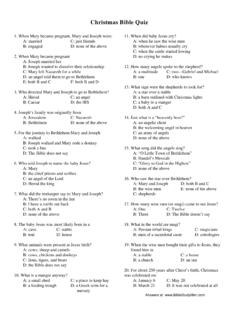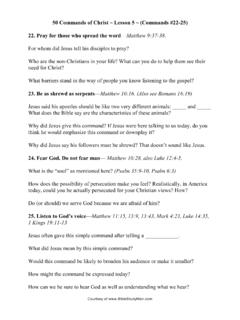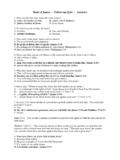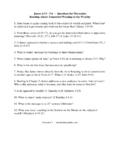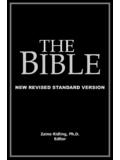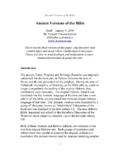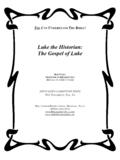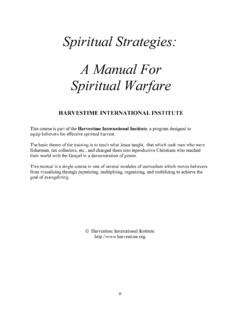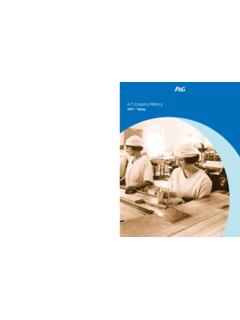Transcription of The Bible: Translations and Types - SwapMeetDave
1 The bible : Translations and Types Languages of the bible Obviously, the bible was not originally written in English, Italian or any modern language. The Old Testament was written primarily in Hebrew with small parts in Aramaic. However, while Jesus most likely spoke Aramaic, most of the New Testament was originally written in Greek. Thus, all modern Bibles are Translations of these original languages. Methods of translation 1. Literal translation . Attempts to keep the exact words and phrases of the original. It is faithful to the original text, but sometimes hard to understand. Keeps a constant historical distance.
2 Examples: King James Version (KJV), New American Standard bible (NASB). 2. Dynamic equivalent (thought for thought) translation . Attempts to keep a constant historical distance with regard to history and facts, but updates the writing style and grammar. Examples: New International Version (NIV), Revised English bible (REB). 3. Free translation (paraphrase). Translates the ideas from the original text but without being constrained by the original words or language. Seeks to eliminate historical distance. Readable, but possibly not precise. Examples: Living bible (LB), The Message. Types of Bibles Most Translations are available in several different Types of bible .
3 Here are just a few of the many different kinds of Bibles. 1. Traditional. Text only. Minimal footnotes. 2. Study bible . Such Bibles usually have extensive footnotes and explanatory notes next to the columns of text. They may also have extensive cross references, a narrative commentary, and maps. (Some also have a cyclopedic index and/or a concordance see Reference bible .). 3. Reference bible . Usually has a cyclopedic index (like an encyclopedia with a reference to the verse where the word or thought is used), a concordance (like a dictionary of common words with examples of their usage and verse references for each example), and maps.
4 4. Place in Life bible . Has meditations and thoughts about issues of concern to people at a particular stage in life. There are versions of these Bibles aimed at men, women, sports players, recovering addicts, new believers, converted Jews, small group members, and many others. 5. One-Year Bibles. Divided into 365 readings for each day of the year, usually with each having a portion of the Old Testament, New Testament, Psalms, and Proverbs. 6. Pastor's bible . Includes protocol outlines and recommended verses for hospital visits, weddings, funerals, and other events. Often has answers to frequently asked questions.
5 7. Children's bible . Usually includes color drawings, maps, and simplified stories. 8. Parallel bible . Has from two to eight Translations side by side. 9. Chronological bible . Entire bible in one continuous story with narration to cover gaps and make everything flow. The four gospels are harmonized into one, for example, and the writings of the prophets are placed in the proper historical place in the books of history 10. Other Specialty Bibles. The Serendipity bible , The Quest, Key Word bible , Leadership bible , Hebrew-Greek Keyword bible , Here's Hope bible , Serenity bible , and many others. My Personal Recommendation For your main reading and study, use a dynamic equivalent translation (balanced between literal and paraphrase).
6 Get one that draws upon newly-discovered sources (after 1966). The most widely used bible today in the is the New International Version (NIV), which is a good choice. Select a type with good explanations, either a Study bible or a Student bible . Augment your main bible with two or three others that appeal to you. David Ahl, 2015. bible Translations Comparison Chart Word for Word Translations Reading Description Level Interlinear 12 + The original Masoretic (Jewish) text in Hebrew and Greek. English Translations available. Very difficult to read and understand. Need a concordance. New American Standard (NASB) 1971, updated 1995.
7 A revision of the American Standard Version of 1901. Formal modern English;. somewhat difficult but more readable than KJV. Amplified 1965. Modern English version from original Greek text. Has bracketed words and phrases to help explain more difficult and complicated passages. English Standard Version (ESV) 2001. A literal translation that makes use of recently discovered sources. Easier reading than other word for word Translations . King James Version (KJV) 1611 (revised 1769). Draws heavily on Bishops bible (1568) and on Geneva bible (1560). Difficult to read and understand due to 17th Century vocabulary and style.
8 Uses no original or recently discovered sources. New King James Version (NKJV) 1982. Taken directly from KJV but with more modern words. Choppy reading because it maintains 17th Century sentence structure. Revised Standard Version (RSV) 1952. A revision of the ASV of 1901. Further revision to New Testament in 1971. Widely accepted by both Protestant and Roman Catholic churches. Holman Christian Standard (HCSB) 2004. Highly readable, accurate translation in modern English. Good balance between word-for-word and thought-for-thought called optimal equivalence.. Thought for Thought New Revised Standard Version 1990. Revision of RSV, still literal, but moves in the (NRSV) thought-for-thought direction.
9 Language not updated but tends to gender neutrality and political correctness. New American bible (NAB) 1970 with updates to 1991. Clear, straightforward translation from the Greek. The first Roman Catholic bible in modern American English. New Jerusalem bible (NJB) 1986. Revision of Jerusalem bible (1966). Roman Catholic. Highly readable modern translation . Thought for Thought continued Reading Description Level New International Version (NIV) 1978-1984. Completely new translation from oldest and best Hebrew, Greek, and Aramaic sources. Accurate, smooth reading version in modern English. Most widely used bible in USA.
10 Today's NIV (TNIV, 2005) and revised NIV from Biblica (2011) are gender neutral versions of NIV. Revised English bible (REB) 1989. Revision of New English bible (1970). More literary than NIV and more dynamic equivalence. Highly readable. Most widely used bible in UK. New Century Version (NCV) 1987. Revision of International Children's bible aimed at young readers and those with low reading skills. Gender neutral version published 1991. New Living translation (NLT) 1996, updated 2004. Converts the paraphrased Living bible to a thought-for-thought translation . Highly readable in vocabulary and language. Gender neutral.

